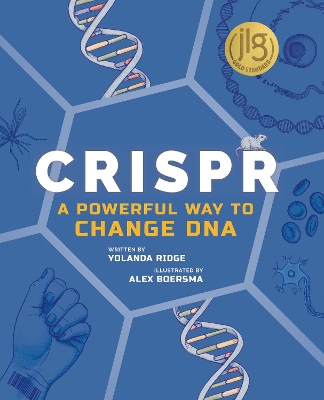Reviewed by annieb123 on
CRISPR: A Powerful Way to Change DNA is a primer on the CRISPR family of sequences and their biotechnological applications aimed at providing layman accessible explanations for the science and theory behind the concepts. Due out 8th Sept 2020 from Annick Press, it's 116 pages and will be available in hardcover and paperback formats.
Ostensibly aimed at young people, this is a good introduction to the science for middle grades up through adults. The author has a facility with science writing and renders the concepts fairly easy to understand for the average reader of whatever age. The layout is logical: a background capsule survey of genetics leads into specific areas where applications of the biotechnology has potentially world changing outcomes. The author's explanation of CAS proteins (and CAS9 in particular) is one of the simplest and best I've come across.The language is not unnecessarily scientific, though it is factual and requires some effort to really assimilate.
The book is well illustrated with line drawings throughout which give a more easily assimilated graphic representation of some of the salient concepts. It should be noted that this book is written about advanced biotechnology and for readers without any background at all, some moderate effort will be needed to understand the concepts.
I've been banging on for decades about the importance of STE(A)M education and this is a well written book which would make a superlative selection for classroom or home libraries, especially for young science interested readers. One (small) quibble with the book is that the author resorts to cutesy alliterative chapter titles (Mutant Mosquitoes, Cancer Cured, Perfect Potatoes, Death Defeated). That might've well been an editorial judgement, who knows, but it doesn't really add anything to the reading. There are other places where the author draws correlations between past innovations in biotechnology such as IVF and shows that they were also controversial at the time and are now seen as mainstream and innocuous (albeit miraculous). I understand that combating the more sensationalist reactions in the press and the public over technology which they generally have a faulty and incomplete understanding is important, but I think that education and not comparisons must be the way forward. ( in other words: People freaked about IVF then, but it turned out fine, so don't worry about splicing fluorescent jellyfish genes into your tropical fish, look, they glow green!).
My "day job" is in biotechnology in a pathology laboratory which sees these and other techniques as an unquestionably *vital* step in isolating and treating (and someday curing) a host of diseases. This -is- going to be the way forward in medicine and other areas of biotechnology (plastic eating bacteria, food security and abundance, helping solve climate change, etc).
This will not be a super easy book for most readers. It is a good book for especially science interested young people or determined adult learners.
Five stars mostly for doing a decent job of explaining very complex concepts in a layman accessible manner.
Disclosure: I received an ARC at no cost from the author/publisher for review purposes
Reading updates
- Started reading
- 4 August, 2020: Finished reading
- 4 August, 2020: Reviewed
